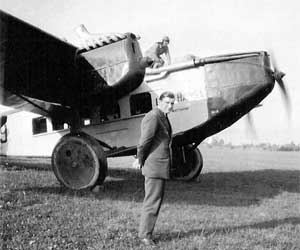
The Heinkel He 70 Blitz ("lightning") was a fast monoplane aircraft designed and produced by the German aircraft manufacturer Heinkel Flugzeugwerke. It was the first Schnellbomber operated by the Luftwaffe.

The Dornier Do J Wal ("whale") is a twin-engine German flying boat of the 1920s designed by Dornier Flugzeugwerke. The Do J was designated the Do 16 by the Reich Air Ministry (RLM) under its aircraft designation system of 1933.

The Dornier Do X was the largest, heaviest, and most powerful flying boat in the world when it was produced by the Dornier company of Germany in 1929. First conceived by Claude Dornier in 1924, planning started in late 1925 and after over 240,000 work-hours it was completed in June 1929.

The Dornier Do 18 was a development of the Do 16 flying boat. It was developed for the Luftwaffe, but Deutsche Luft Hansa received five aircraft and used these for tests between the Azores and the North American continent in 1936 and on their mail route over the South Atlantic from 1937 to 1939.

The Savoia-Marchetti S.55 was a double-hulled monoplane flying boat designed and produced by the Italian aircraft manufacturer Savoia-Marchetti. It was designed to perform both commercial and military applications.

The Saro A17 Cutty Sark was a British amphibious aircraft from the period between World War I and World War II, built by the British firm Saunders-Roe. The aircraft was named after the ship Cutty Sark, rather than the garment or the fictional witch.

The Lioré et Olivier LeO H.242 was a monoplane flying boat aircraft designed and produced by the French aircraft manufacturer Lioré et Olivier. It was used for European passenger air services in the 1930s, including by the flag carrier Air France. One LeO H.242 was depicted near the end of Hergé's The Adventures of Tintin comic King Ottokar's Sceptre.

The Junkers G 24 was a German three-engine, all-metal low-wing monoplane passenger aircraft manufactured by Junkers from 1925. Junkers F 24 was the designation for single-engine versions of the same aircraft.

The Dornier Komet (Comet), Merkur (Mercury), Do C, Do D, and Do T were a family of aircraft designed and manufactured by the German aircraft manufacturer Dornier Flugzeugwerke.

The Focke-Wulf A 17 Möwe was an airliner designed and produced by the German aircraft manufacturer Focke-Wulf. It was the company's first large commercial aircraft.

The Rohrbach Ro V Rocco was a twin-engined seaplane that was designed and manufactured by the German aircraft manufacturer Rohrbach Metall-Flugzeugbau.

The Junkers G 31 was an advanced tri-motor airliner designed and produced by the German aircraft manufacturer Junkers. It would be the first airliner operated by Deutsche Luft Hansa to feature a flight attendant.

The Latécoère 380 was a flying boat aircraft designed and produced by the French aircraft manufacturer Latécoère. It was designed for use on Aéropostale's mail routes to South America, the aircraft subsequently saw military service as a maritime patrol aircraft.

The Latécoère 500 was a flying boat designed and produced by the French aircraft manufacturer Latécoère.

The Lioré et Olivier H-190 was a biplane flying boat aircraft designed and produced by the French aircraft manufacturer Lioré et Olivier.

The Rohrbach Ro VIII Roland was an semi-cantilever monoplane trimotor airliner designed and produced by the German aircraft manufacturer Rohrbach. It was capable of unrivalled performance in some categories; during its early years, the type held no less than 22 world records.

The Richard-Penhoët 2 was a 1926 French, large, five-engined flying-boat airliner, carrying up to twenty passengers. The sole example flew in 1926 but was lost in 1928 during testing after modification to improve performance.

The Caproni Ca.90 was a prototype heavy bomber designed and built by the Italian aircraft manufacturer Caproni. At the time of its maiden flight on 13 October 1929, it was the largest land-based aircraft then extant in the world; the First World War-era Siemens-Schuckert R.VIII having been slightly larger. Only the one Ca.90 was ever built.

The SPCA Météore 63 was a biplane flying boat airliner designed and built by the French aircraft manufacturer Société Provençale de Constructions Aéronautiques (SPCA). It was the company's first aircraft, as well as the first seaplane to fulfil the strenuous conditions to secure a seaworthiness certificate of the first class and the first long distance seaplane to be procured by the French government.

The Rohrbach Ro VII Robbe was an all-metal, twin engine flying boat built in Germany in the 1920s. It could be adapted to commercial or military rôles.























